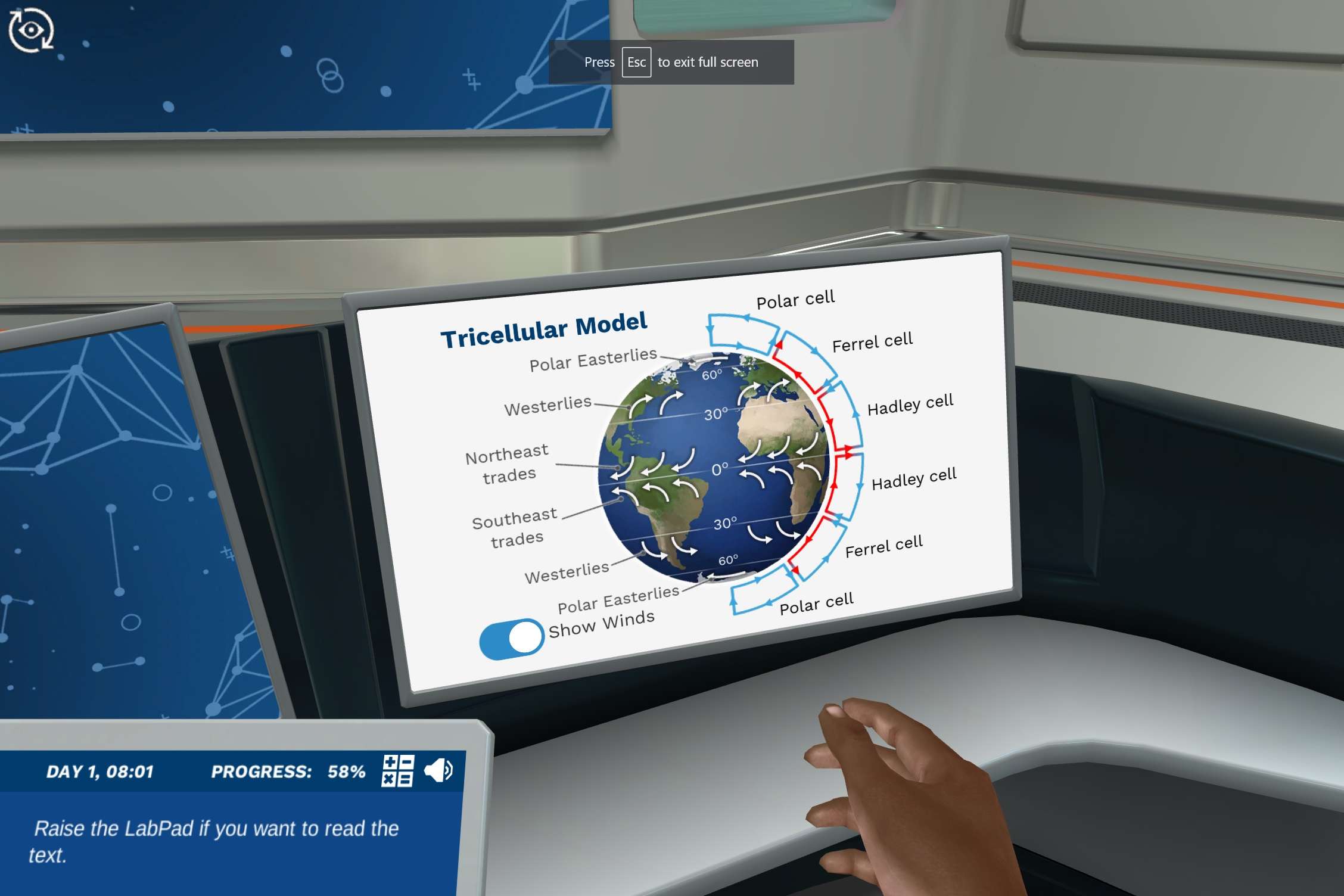Heading 1
Heading 2
Heading 3
Heading 4
Heading 5
Heading 6
Lorem ipsum dolor sit amet, consectetur adipiscing elit, sed do eiusmod tempor incididunt ut labore et dolore magna aliqua. Ut enim ad minim veniam, quis nostrud exercitation ullamco laboris nisi ut aliquip ex ea commodo consequat. Duis aute irure dolor in reprehenderit in voluptate velit esse cillum dolore eu fugiat nulla pariatur.
Block quote
Ordered list
- Item 1
- Item 2
- Item 3
Unordered list
- Item A
- Item B
- Item C
Bold text
Emphasis
Superscript
Subscript
About This Simulation
Discover the patterns of atmospheric circulation and the role it plays in influencing local climates and biomes around the world. Then use this knowledge to determine the biome and latitude of the lab!
Learning Objectives
- Describe how the atmospheric circulation causes the prevailing winds around the globe and drives the heat flow
- Understand how general atmospheric pressure differences at different latitudes (and differing amounts of incoming solar radiation) drive the atmospheric circulation cell system
- Relate the atmospheric circulation phenomenon to the climatic conditions that define the Earth’s biomes
About This Simulation
Lab Techniques
- Tricellular model
- Patterns of atmospheric circulation
- The Coriolis effect
- Climate
- Biomes
Related Standards
- HS-ESS2-4
- ESS2.D-H1
Learn More About This Simulation
How do wind, latitude, and air pressure influence biomes? In this simulation, you will investigate the similarities and differences between different biomes and their climates, and how they are influenced by atmospheric circulation!
Explore the tricellular model
Use an interactive tricellular model to learn about the different convection cells which drive atmospheric circulation: the Hadley cells, the Ferrel cells, and the Polar cells. You will look at how heat drives airflow and what causes air pressure to differ at different latitudes. You will also learn about the different prevailing winds: the trades, westerlies, and polar easterlies. You will match the prevailing winds to their corresponding cell and understand how the Coriolis effect influences their direction.
Investigate different biomes Explore six major biomes using a futuristic holotable and learn all about their climatic characteristics, such as air pressure, winds, rainfall, and temperature. Then, with the additional help of a large world map of Earth’s biomes, you will determine the general latitude of each biome and relate its position to the convection cells of the tricellular model. While completing this mission, you will use your knowledge of atmospheric circulation to understand the role it plays in influencing the formation of biomes at different latitudes.
Find the lab’s location!
Using the clues and knowledge you have gained throughout the simulation, you will determine the biome and latitude of the lab! Could you identify the biome and latitude of a given location knowing only some key environmental and climatic characteristics?
For Science Programs Providing a Learning Advantage
Boost STEM Pass Rates
Boost Learning with Fun
75% of students show high engagement and improved grades with Labster
Discover Simulations That Match Your Syllabus
Easily bolster your learning objectives with relevant, interactive content
Place Students in the Shoes of Real Scientists
Practice a lab procedure or visualize theory through narrative-driven scenarios


FAQs
Find answers to frequently asked questions.
Heading 1
Heading 2
Heading 3
Heading 4
Heading 5
Heading 6
Lorem ipsum dolor sit amet, consectetur adipiscing elit, sed do eiusmod tempor incididunt ut labore et dolore magna aliqua. Ut enim ad minim veniam, quis nostrud exercitation ullamco laboris nisi ut aliquip ex ea commodo consequat. Duis aute irure dolor in reprehenderit in voluptate velit esse cillum dolore eu fugiat nulla pariatur.
Block quote
Ordered list
- Item 1
- Item 2
- Item 3
Unordered list
- Item A
- Item B
- Item C
Bold text
Emphasis
Superscript
Subscript
A Labster virtual lab is an interactive, multimedia assignment that students access right from their computers. Many Labster virtual labs prepare students for success in college by introducing foundational knowledge using multimedia visualizations that make it easier to understand complex concepts. Other Labster virtual labs prepare learners for careers in STEM labs by giving them realistic practice on lab techniques and procedures.
Labster’s virtual lab simulations are created by scientists and designed to maximize engagement and interactivity. Unlike watching a video or reading a textbook, Labster virtual labs are interactive. To make progress, students must think critically and solve a real-world problem. We believe that learning by doing makes STEM stick.
Yes, Labster is compatible with all major LMS (Learning Management Systems) including Blackboard, Canvas, D2L, Moodle, and many others. Students can access Labster like any other assignment. If your institution does not choose an LMS integration, students will log into Labster’s Course Manager once they have an account created. Your institution will decide which is the best access method.
Labster is available for purchase by instructors, faculty, and administrators at education institutions. Purchasing our starter package, Labster Explorer, can be done using a credit card if you are located in the USA, Canada, or Mexico. If you are outside of North America or are choosing a higher plan, please speak with a Labster sales representative. Compare plans.
Labster supports a wide range of STEM courses at the high school, college, and university level across fields in biology, chemistry, physics, and health sciences. You can identify topics for your courses by searching our Content Catalog.















